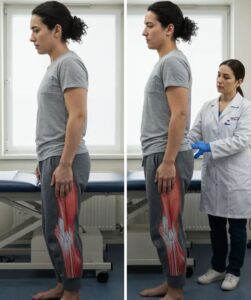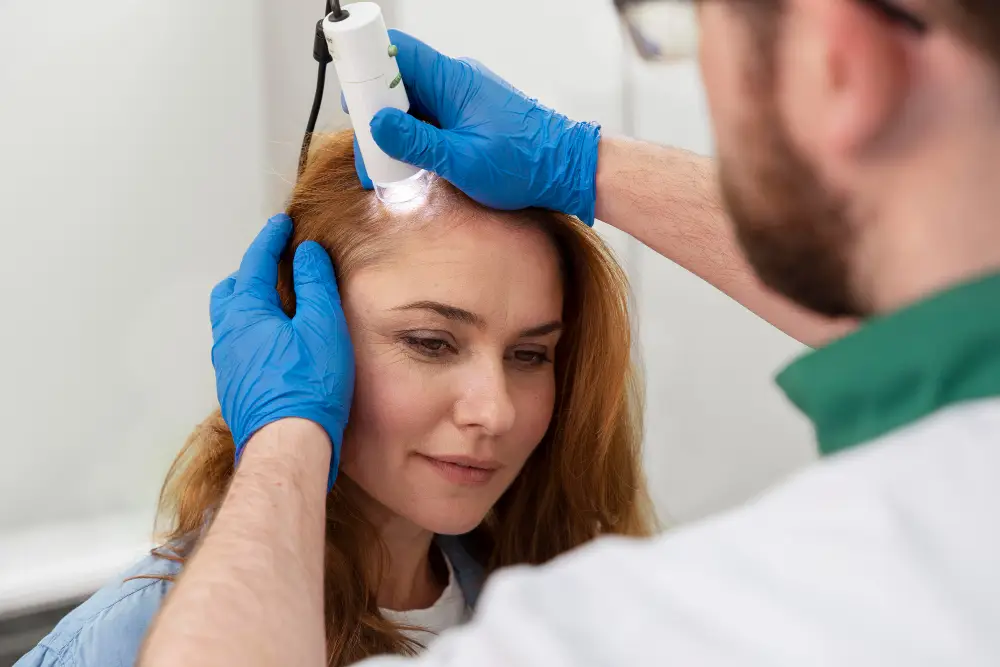
Key Takeaways for Navigating Sciatic Nerve Damage
- **Sciatica’s Impact:** Chronic sciatic nerve damage profoundly impacts quality of life, often leading to debilitating pain, limited mobility, and emotional distress. Traditional treatments can provide temporary relief, but many seek more enduring solutions.
- **Understanding Stem Cell Pathways:** Modern biological approaches, including stem cell therapies, are being explored for their potential to support the body’s natural healing and regenerative processes for nerve tissue and pain modulation, an area of active research.
- **Pereira, Colombia as an Option:** Colombia boasts a well-regulated healthcare system, with facilities like those supported by the team at Regencord in Pereira offering high standards of care within a serene and supportive environment.
- **Comprehensive Patient Support:** Addressing the complexities of international medical care, dedicated patient advocacy teams provide end-to-end logistical and communicative support, making the journey less daunting.
- **Informed Decision-Making:** The critical first step is a confidential case review, allowing individuals to gain clarity, understand potential pathways, and make empowered decisions about their health without pressure.
Stem Cell Treatment for Sciatic Nerve Damage: Understanding Your Options for a Brighter Future
Table of Contents
- Introduction: Beyond Persistent Pain
- The Stakes & Critical Implications of Sciatic Nerve Damage
- The Conventional Approach to Sciatica in North America
- Exploring Regenerative Pathways: Supporting Nerve Health
- The Pereira, Colombia Advantage: A Holistic Approach to Care
- Regencord’s Sciatica Clarity Compass: Your Guide to Informed Decisions
- Our Regenerative Philosophy & Approach
- Overcoming Common Hesitations: Why Seeking Clarity is a Strategic Advantage
- Glossary of Key Terms
- Frequently Asked Questions (FAQ)
- Take the Next Step: Your Confidential Case Review
- Disclaimer
Introduction: Beyond Persistent Pain
Living with sciatic nerve damage can be an arduous journey. The sharp, often debilitating pain that radiates from your lower back, down through your hip and leg, isn’t just a physical discomfort; it often disrupts every aspect of life – from work and hobbies to sleep and emotional well-being. Many individuals find themselves caught in a cycle of temporary relief, continually searching for a more lasting and meaningful solution. The frustration, anxiety, and sense of limitation can be overwhelming.
At Regencord, located in the beautiful and medically advanced city of Pereira, Colombia, we understand this journey intimately. Our team recognizes that those exploring options for sciatic nerve damage are not simply seeking a new treatment; they are seeking clarity, hope, and a path forward that addresses the root of their discomfort and supports their body’s natural capacity for healing. This comprehensive guide is designed to provide you with a deep understanding of regenerative approaches, including the role of cellular therapies, for sciatic nerve damage. Our aim is to empower you with verifiable information, grounded in scientific exploration, and to transparently present the unique advantages of considering Pereira, Colombia, as a destination for your care.
This resource reflects the knowledgeable, ethical, and patient-centric ethos of the Regencord team. We believe in education first, empowering you to make confident, informed decisions about your health. We will explore how innovative biological support may assist with nerve regeneration, offer neuropathic pain relief, and contribute to functional improvement, all within a framework of ethical persuasion and strict adherence to regulatory standards.
The Stakes & Critical Implications of Sciatic Nerve Damage

Sciatica, characterized by pain along the sciatic nerve pathway, is often caused by compression or irritation of the nerve roots in the lower spine. This compression can stem from a herniated disc, spinal stenosis, or other spinal conditions. The implications extend far beyond the immediate pain:
- **Chronic Pain Cycle:** Persistent pain can lead to a reliance on pain medication, which may have its own set of concerns. The continuous discomfort also frequently disrupts sleep patterns, leading to fatigue and reduced coping mechanisms.
- **Functional Limitations:** Sciatic nerve damage can severely limit mobility, making simple tasks like walking, sitting, or standing difficult. This impacts work, exercise, and social engagement, leading to a diminished quality of life.
- **Emotional & Psychological Toll:** The chronic nature of the condition often leads to feelings of frustration, anxiety, depression, and a sense of isolation. Individuals may feel their independence is being eroded, and their future uncertain. As a study highlighted by the NIH’s National Institute of Neurological Disorders and Stroke (NINDS) suggests, chronic pain conditions like sciatica can significantly impair daily activities and overall well-being.
- **Potential for Nerve Degeneration:** If nerve compression is prolonged, it can potentially lead to more significant nerve degeneration, impacting motor function and sensation in the affected limb.
Understanding these profound implications underscores the urgent need for pathways that do more than just manage symptoms—pathways that genuinely aim to support the body’s natural processes for healing and recovery.
The Conventional Approach to Sciatica in North America

In many regions, including North America, the conventional treatment paradigm for sciatic nerve damage typically follows a stepped approach, starting with conservative measures. These often include:
- **Physical Therapy:** Exercises and stretches designed to improve posture, strengthen core muscles, and increase flexibility.
- **Medication:** Over-the-counter pain relievers, prescription anti-inflammatory drugs, muscle relaxants, or neuropathic pain medications.
- **Steroid Injections:** Epidural steroid injections are commonly used to reduce inflammation around the sciatic nerve roots, providing temporary relief.
- **Surgery:** For severe cases that do not respond to conservative treatments, surgical options like microdiscectomy or laminectomy may be considered to relieve nerve compression.
While these approaches, often guided by organizations like the American Academy of Orthopaedic Surgeons (AAOS) or the American Academy of Physical Medicine and Rehabilitation (AAPMR), can be effective for many, they don’t always provide lasting relief for everyone. Many individuals experience recurring pain or find that conventional methods do not adequately address the underlying nerve health. This leads to a profound sense of isolation and a cycle of temporary relief. They are not merely seeking a ‘treatment’ but a comprehensive pathway that addresses both their physical pain and the emotional toll of their condition, often finding peace of mind in environments that prioritize holistic well-being alongside medical innovation.
Exploring Regenerative Pathways: Supporting Nerve Health
The field of regenerative medicine is continually advancing, offering new perspectives on how the body’s inherent healing capabilities can be supported. For conditions like sciatic nerve damage, the focus shifts from merely managing symptoms to exploring biological approaches that may aid in nerve regeneration, offer neuropathic pain relief, and contribute to functional improvement.
What are Cellular Therapies and How Might They Help?
Cellular therapies, often involving mesenchymal stem cells (MSCs), are a key area of interest within regenerative medicine. While research is ongoing and outcomes can vary, the scientific community, as highlighted by various PubMed-indexed peer-reviewed journals and ongoing studies registered on ClinicalTrials.gov, is actively investigating how these cells might contribute to:
- **Modulating Inflammation:** Chronic inflammation is a significant contributor to nerve pain and damage. Cellular therapies are being studied for their potential to reduce inflammation in the affected area, which could alleviate pressure and irritation on the sciatic nerve.
- **Supporting Tissue Repair:** Damaged nerve tissue, particularly the myelin sheath that insulates nerve fibers, can struggle to repair itself. Biological approaches aim to provide growth factors and other signaling molecules that may encourage the body’s own repair mechanisms, potentially supporting nerve regeneration.
- **Promoting Angiogenesis:** Improved blood supply (angiogenesis) to the damaged area can be crucial for healing. Cellular therapies are explored for their capacity to enhance local vascularization, bringing essential nutrients and oxygen to the compromised nerve.
- **Neuropathic Pain Relief:** Beyond structural repair, these therapies are also investigated for their potential to influence pain pathways, offering relief from the chronic neuropathic pain associated with sciatic nerve damage.
It’s important to understand that these approaches are not “cures” or “guarantees” but rather innovative biological support mechanisms. The objective is to work with the body’s natural processes, aiming to create a more conducive environment for healing and functional improvement. The NIH continues to be a leading source for information on the ethical and scientific considerations surrounding stem cell research and its applications.
The Pereira, Colombia Advantage: A Holistic Approach to Care

When considering advanced regenerative pathways for sciatic nerve damage, the choice of location for your care is as crucial as the treatment itself. Pereira, Colombia, emerges as a compelling destination, offering a unique blend of medical excellence, patient-centric support, and a restorative environment.
A Robust and Regulated Healthcare Landscape
Colombia has invested significantly in its healthcare infrastructure, developing a system that adheres to high international standards. For those concerned about the safety and legitimacy of international medical care, Colombia provides a reassuring framework:
- **Accredited Facilities:** Many medical facilities in Colombia, including those supported by the team at Regencord, boast modern technology and adhere to rigorous quality controls. Hospitals are often internationally accredited, reflecting a commitment to patient safety and clinical excellence.
- **Highly Trained Medical Professionals:** Colombian medical universities are renowned, producing doctors and surgeons who are well-educated, often with international training and experience in advanced medical techniques.
- **Government Oversight:** The Colombian Ministry of Health and INVIMA, the national regulatory agency, maintain strict oversight on medical practices, pharmaceutical products, and biological therapies. This regulatory environment ensures a structured and accountable approach to medical care, providing a layer of confidence for international patients.
The Regencord Experience: Patient Advocacy and Seamless Care
One of the primary concerns for anyone considering international medical care is the complexity of logistics. The Regencord team in Pereira, Colombia, specializes in transforming this potential barrier into a streamlined, supportive experience. We understand that individuals suffering from chronic sciatic nerve damage need comprehensive guidance and a clear pathway forward. They don’t want to navigate a foreign system alone.
“Pereira, Colombia, offers a distinctive advantage for those seeking advanced regenerative medicine options, extending beyond the medical procedure itself. The region provides a unique confluence of high-standard medical facilities, a professional and empathetic care team, and a serene, recuperative environment that is conducive to healing. Patients often discover that the reduced logistical and financial pressures, combined with the region’s therapeutic climate, significantly enhance their overall recovery experience compared to high-stress, high-cost medical hubs.”
Our dedicated patient advocacy team acts as your trusted liaison, assisting with:
- **Initial Consultation & Assessment:** Facilitating confidential reviews to determine if you are a potential candidate for the regenerative pathways available.
- **Travel & Accommodation:** Guiding you through travel planning, including flights, local transport, and comfortable accommodation options that suit your recovery needs.
- **Language Support:** Ensuring clear communication throughout your journey, with interpreters available as needed.
- **Coordination of Care:** Seamlessly scheduling appointments, procedures, and post-treatment follow-ups, reducing stress and allowing you to focus on your well-being.
- **Post-Treatment Support:** Offering guidance for your recovery period and maintaining open lines of communication for any questions that may arise.
A Restorative Environment for Healing
Pereira, nestled in Colombia’s picturesque Coffee Axis, offers more than just advanced medical facilities. It provides a naturally therapeutic backdrop that is highly conducive to healing and recovery. The mild climate, lush landscapes, and tranquil atmosphere contribute to a holistic care environment often missing in bustling urban medical centers. This serene setting, combined with culturally warm hospitality, can significantly reduce stress and promote mental well-being, which are vital components of any healing journey.
“Individuals suffering from chronic sciatic nerve damage often embark on a prolonged and emotionally taxing journey, cycling through various treatments that offer only temporary relief. They are not simply looking for a new therapy but a supportive ecosystem that understands the profound impact of their condition on their quality of life, offering clear communication, comprehensive guidance, and a pathway that addresses both the physical discomfort and the psychological burden, allowing them to regain agency in their health decisions.”
Choosing Pereira for your regenerative care means opting for an environment where your physical treatment is complemented by a setting that nurtures overall health and peace of mind.
Regencord’s Sciatica Clarity Compass: Your Guide to Informed Decisions

Navigating the complexities of sciatic nerve damage and exploring innovative treatment pathways can feel like traversing unfamiliar territory. To empower you with structure and confidence, we’ve developed **Regencord’s Sciatica Clarity Compass** – a practical resource tool designed to guide you through the process of understanding your options.
How to Use Your Clarity Compass:
- **Assess Your Current Situation:**
- What are your primary symptoms (pain level, location, frequency, other sensations)?
- How significantly does sciatic nerve damage impact your daily activities, sleep, and emotional state?
- Which conventional treatments have you tried, and what were their outcomes?
- What are your main concerns or frustrations with your current medical pathway?
- **Identify Your Information Needs:**
- What do you want to learn about biological support for nerve health and neuropathic pain relief?
- What questions do you have about the science behind these approaches? (e.g., How do cellular therapies interact with nerve tissue? What research supports their exploration?)
- What are your specific concerns about safety, efficacy expectations, or ethical considerations?
- **Explore the Pereira Advantage:**
- What are your questions about the healthcare standards in Colombia, particularly in Pereira?
- How important is a restorative environment to your healing process?
- What logistical support would you need for international travel and care? (e.g., travel planning, accommodation, language assistance, post-treatment follow-up).
- **Prepare for Your Confidential Review:**
- Gather any relevant medical records (diagnosis, imaging, previous treatment reports).
- List all your questions and concerns for the Regencord team.
- Articulate your goals and expectations for pursuing advanced pathways.
- **Make an Empowered Decision:**
- After gathering information and consulting with our team, evaluate if the regenerative pathways align with your personal health goals and values.
- Consider the comprehensive support offered by the Regencord team in facilitating your journey.
- Trust your informed judgment to decide on the best path forward for your well-being.
Regencord’s Sciatica Clarity Compass is more than a checklist; it’s a framework designed to help you organize your thoughts, articulate your needs, and prepare for a meaningful discussion with our team, ensuring you feel confident and supported at every stage of your exploration.
Our Regenerative Philosophy & Approach

At Regencord in Pereira, Colombia, our philosophy is rooted in a deep respect for the human body’s capacity for healing and a commitment to ethical, patient-centered care. We understand that true well-being encompasses more than just the absence of symptoms; it involves a holistic approach that supports both physical recovery and mental peace.
An Educational and Supportive Foundation
Our approach begins with education. We believe that an informed patient is an empowered patient. We dedicate ourselves to providing clear, accessible information about the science behind biological support for sciatic nerve damage. Our discussions draw upon verifiable research from like the NIH and PubMed, explaining how cellular therapies are being explored for their potential to aid nerve regeneration, reduce inflammation, and offer neuropathic pain relief. We foster an environment where questions are welcomed, and understanding is prioritized.
Patient-Centric Pathways
Every individual’s journey with sciatic nerve damage is unique. Therefore, our team in Pereira focuses on developing highly personalized pathways. This means:
- **Thorough Assessment:** A comprehensive review of your medical history, current condition, and previous treatments to understand your specific needs.
- **Ethical Considerations:** All discussions and potential pathways are presented within a strict ethical framework, ensuring transparency regarding the current understanding of regenerative medicine and avoiding any unverified claims or guarantees. Our objective is to explore possibilities, not to promise outcomes.
- **Holistic Support:** Recognizing that stress and environment play a significant role in healing, our philosophy extends to supporting your well-being beyond the clinical setting. We aim to provide a nurturing atmosphere that contributes to your overall recuperation.
Collaboration and Continuity of Care
Our team works collaboratively to ensure continuity of care. From your initial confidential case review to coordinating your journey in Pereira and offering post-treatment support, we are dedicated to being a consistent source of guidance. We value open communication and strive to build trust through every interaction.
The Regencord philosophy for addressing sciatic nerve damage is about offering innovative, biologically-informed pathways within a supportive, ethical, and transparent framework, all designed to empower you on your path to improved well-being.
Overcoming Common Hesitations: Why Seeking Clarity is a Strategic Advantage
It’s natural to have questions and concerns when considering advanced medical pathways, especially those involving international travel for a complex condition like sciatic nerve damage. Many potential patients share similar hesitations. Let’s address them directly, reframing common barriers into opportunities for informed decision-making and strategic advantage.
“Stem cell treatments for nerve damage sound experimental, unproven, or like a ‘miracle cure,’ especially if not widely available in my home country.”
This is a common and valid concern. It’s crucial to understand that biological approaches for conditions like sciatic nerve damage are not presented as “miracle cures” or unverified solutions. Instead, they are explored as *exploratory biological approaches* aimed at supporting the body’s intrinsic healing mechanisms. The scientific community, as evidenced by ongoing research at institutions like the NIH and numerous studies in PubMed-indexed journals, is actively investigating how various cellular therapies may contribute to tissue repair and modulating inflammatory responses in nerve injuries. Our discussions focus on the *potential* for enhanced cellular support, grounded in current scientific understanding and ethical frameworks, rather than making efficacy claims. Seeking clarity means understanding this distinction and evaluating the science-backed principles that guide these innovative pathways.
“I’m concerned about the safety and regulatory standards of medical care, especially for something as complex as nerve damage treatment, in a country like Colombia.”
Concerns about safety and legitimacy abroad are perfectly understandable. However, Colombia boasts a robust, government-regulated healthcare infrastructure. Medical facilities and procedures, including those supported by the team at Regencord, are subject to stringent national standards. Oversight bodies like the Colombian Ministry of Health and INVIMA ensure adherence to quality and safety protocols. By focusing on verifiable facts—Colombia’s robust healthcare infrastructure, specific government accreditations, and the high standards of medical training in the region—we shift the focus from fear of the unknown to an understanding of a well-regulated system. Our team is committed to transparency, due diligence, and operating within these established ethical and legal frameworks, providing a trustworthy pathway to care.
“The logistics of traveling internationally for medical treatment, especially with debilitating sciatic pain, seem overwhelming and too complicated to manage.”
The thought of coordinating international travel, accommodation, and medical appointments while managing chronic pain can indeed feel insurmountable. This is precisely why the Regencord team has developed a comprehensive patient advocacy system. We acknowledge your valid logistical anxieties and transform the perception of complexity into a guided, supported journey. Our dedicated team assists with every step: initial consultation, travel arrangements, accommodation, local transportation, and facilitating clear communication. This ensures that the entire process, from your initial inquiry to post-treatment support, is meticulously coordinated to minimize stress. This transforms what seems like a complex process into a manageable, supported pathway, emphasizing our role in making your journey as smooth as possible, allowing you to focus solely on your well-being.
“I’ve already spent so much money on treatments that didn’t work. How do I know this will be a worthwhile investment, and what are the actual costs?”
The financial and emotional toll of ongoing, ineffective treatments is a significant concern. While we cannot provide specific cost details without a case review or guarantee outcomes, we frame the decision to explore these options as an *investment in clarity and understanding comprehensive solutions*. Our “confidential case review” is designed to provide you with personalized information about potential pathways and what a journey with Regencord might entail, enabling a fully informed decision *before* any financial commitment. Furthermore, exploring comprehensive and holistic care in Pereira can often represent a compelling value proposition compared to the cumulative expenses of fragmented, temporary treatments over time in other regions. It’s about investing in a guided, ethical approach to a chronic condition, empowering you with knowledge and a clear pathway forward.
Seeking clarity through a confidential case review is not a commitment to treatment, but an empowering step towards understanding all your options. It’s a strategic advantage in your journey towards improved health and a brighter future.
Glossary of Key Terms
- Sciatic Nerve Damage:
- Damage or compression of the sciatic nerve, which originates in the lower back and extends down the leg, leading to pain, numbness, or tingling.
- Nerve Regeneration:
- The natural process of repairing or regrowing damaged nerve tissue. Biological therapies are explored for their potential to support this process.
- Neuropathic Pain:
- Chronic pain caused by damage or disease affecting the somatosensory nervous system. Sciatica often involves neuropathic pain components.
- Functional Improvement:
- An enhancement in a person’s ability to perform daily activities and movements, often a primary goal in treating sciatic nerve damage.
- Mesenchymal Stem Cells (MSCs):
- A type of adult stem cell being investigated for its potential role in regenerative medicine due to its properties, including modulating inflammation and supporting tissue repair.
- INVIMA:
- Colombia’s National Food and Drug Surveillance Institute, responsible for regulating health products, medicines, and medical devices.
- Patient Advocacy:
- Support and guidance provided to patients to help them navigate complex healthcare systems, understand their options, and make informed decisions.
- Regenerative Medicine:
- A field focused on developing new methods to regrow, repair, or replace damaged or diseased cells, organs, or tissues.
Frequently Asked Questions (FAQ)
Q: What exactly is sciatic nerve damage?
A: Sciatic nerve damage, or sciatica, refers to pain and discomfort along the path of the sciatic nerve, which branches from your lower back through your hips and buttocks and down each leg. It most commonly occurs when a herniated disc, bone spur on the spine, or narrowing of the spine (spinal stenosis) compresses part of the nerve. This can cause inflammation, pain, and often some numbness or tingling in the affected leg.
Q: How are cellular therapies thought to support nerve regeneration and neuropathic pain relief?
A: Research, including studies highlighted by the NIH and in PubMed-indexed journals, explores how cellular therapies, such as those involving mesenchymal stem cells (MSCs), may support the body’s natural healing processes. The proposed mechanisms include modulating inflammation around the damaged nerve, which can reduce irritation and pain. Additionally, these therapies are investigated for their potential to release growth factors and other signaling molecules that may encourage the body’s own repair of nerve tissue and potentially improve local blood supply (angiogenesis), contributing to overall nerve health and functional improvement.
Q: Is stem cell treatment for sciatic nerve damage regulated in Colombia?
A: Yes, Colombia has a regulated healthcare system. The Colombian Ministry of Health and INVIMA (Instituto Nacional de Vigilancia de Medicamentos y Alimentos) are the primary regulatory bodies. They oversee medical practices, products, and facilities, ensuring adherence to national standards for quality and safety. The team at Regencord operates within these established frameworks, committed to ethical practice and patient safety.
Q: What makes Pereira, Colombia, a suitable destination for this type of care?
A: Pereira offers a compelling combination of advantages: a robust and regulated healthcare infrastructure with modern facilities and highly trained medical professionals, often with international experience. Beyond the medical aspect, the region provides a serene and naturally restorative environment that can be highly conducive to healing. Furthermore, the Regencord team provides comprehensive patient advocacy, assisting with all logistical aspects of international medical travel, making the journey less stressful.
Q: What kind of support does the Regencord team offer for international patients?
A: The Regencord team offers comprehensive patient advocacy support. This includes assisting with initial confidential case reviews, guiding you through travel arrangements (flights, local transportation), arranging comfortable accommodation, providing language support, coordinating all medical appointments and procedures, and offering post-treatment follow-up guidance. Our goal is to make your entire journey as seamless and stress-free as possible.
Q: How can I determine if these regenerative pathways are an option for me?
A: The first step is to engage in a confidential case review with the Regencord team. This involves a thorough discussion of your medical history, current condition, and health goals. This review helps us understand your specific situation and determine if the regenerative pathways available through our team in Pereira, Colombia, align with your needs and are a potential option for you. It’s an opportunity to gain clarity without commitment.
Ready to explore a clear path forward for sciatic nerve damage?
Discover if you are a candidate for the regenerative medicine pathways available through the team at Regencord in Pereira, Colombia.
Contact us for a confidential case review.
Disclaimer: This article is for informational and educational purposes only and does not constitute medical advice or a guarantee of treatment outcomes. The information provided is based on current understanding and ongoing research in regenerative medicine for sciatic nerve damage. All medical decisions should be made in consultation with a qualified healthcare provider. The team at Regencord in Pereira, Colombia, provides medical services. Veris Salus LLC serves as a marketing and patient-coordination facilitator for those exploring international medical care options.



